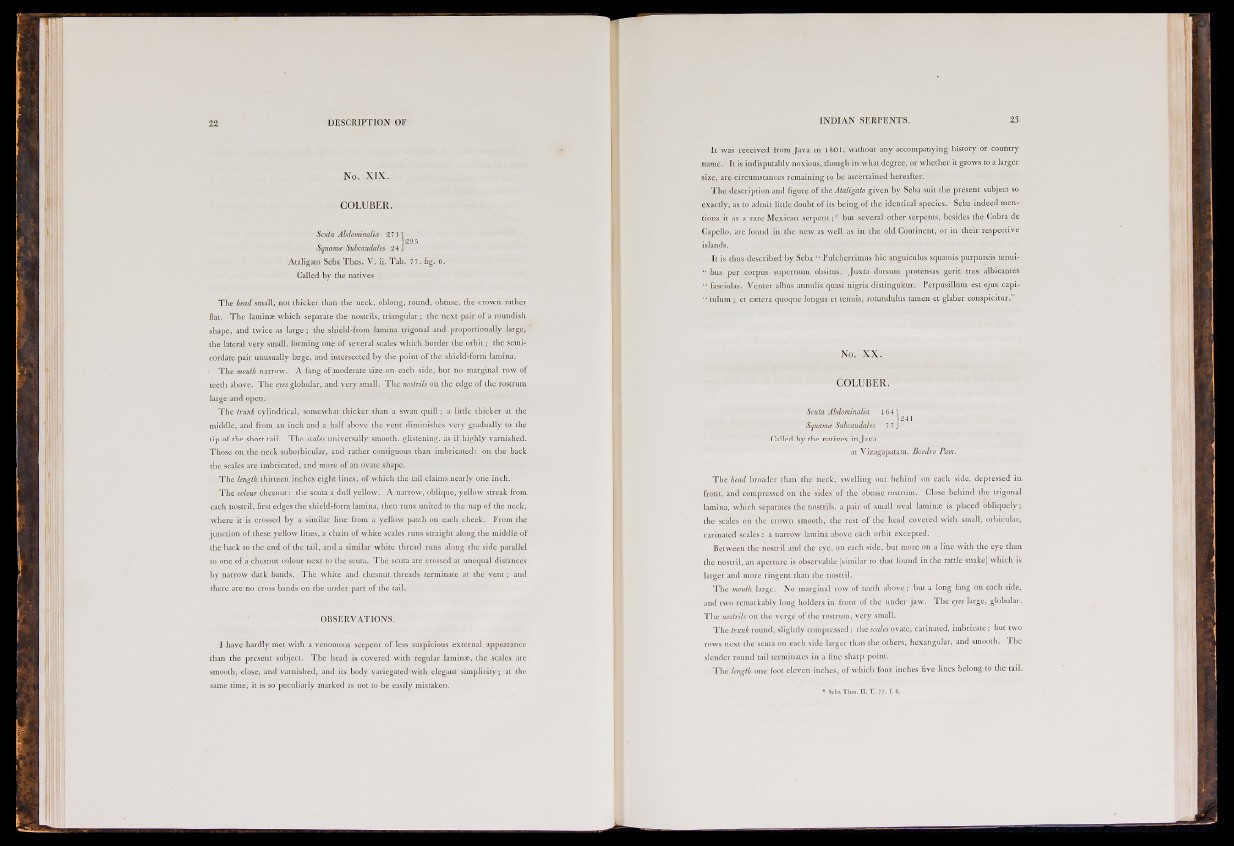
f
22 DESCRIPTION OF
No. XIX.
COLUBER.
Scuta Abdominalia 2711
29 5
Squama Subcaudales 24 J
Ataligato Seba Thes. V. ii. Tab. 7 7. fig. 6.
Called by the natives
The head small, not thicker than the neck, oblong, round, obtuse, the crown rather
flat. The laminae which separate the nostrils, triangular; the next pair of a roundish
shape, and twice as large ; the shield-from lamina trigonal and proportionally large,
the lateral very small, forming one of several scales which border the orbit; the semicordate
pair unusually large, and intersected by the point of the shield-form lamina.
The Ttwuth narrow. A fang of moderate size on each side, but no marginal row of
teeth above. The eyej globular, and very small. The nostrils on the edge of the rostrum
large and open.
The trunk cylindrical, somewhat thicker than a swan quill ; a little thicker at the
middle, and from an inch and a half above the vent diminishes very gradually to the
tip of the short tail. The scales universally smooth, glistening, as if highly varnished.
Those on the neck suborbicular, and rather contiguous than imbricated: on the back
the scales are imbricated, and more of an ovate shape.
The length thirteen inches eight lines, of which the tail claims nearly one inch.
The colour chesnut: the scuta a dull yellow. A narrow, oblique, yellow streak from
each nostril, first edges the shield-form lamina, then runs united to the nap of the neck,
where it is crossed by a similar line from a yellow patch on each cheek. From the
junction of these yellow lines, a chain of white scales runs straight along the middle of
the back to the end of the tail, and a similar white thread runs along the side parallel
to one of a chesnut colour next to the scuta. The scuta are crossed at unequal distances
by narrow dark bands. The white and chesnut threads terminate at the vent ; and
there are no cross bands on the under part of the tail.
OBSERVATIONS.
I have hardly met with a venomous serpent of less suspicious external appearance
than the present subject. The head is covered with regular laminae, the scales are
smooth, close, and varnished, and its body variegated with elegant simplicity; at the
same time, it is so peculiarly marked as not to be easily mistaken.
INDIAN SERPENTS. 23
It was received from Java in 1801, without any accompanying history or country
name. It is indisputably noxious, though in what degree, or whether it grows to a larger
size, are circumstances remaining to be ascertained hereafter.
The description and figure of the Ataligato given by Seba suit the present subject so
exactly, as to admit little doubt of its being of the identical species. Seba indeed mentions
it as a rare Mexican serpent but several other serpents, besides the Cobra de
Capello, are found in the new as well as in the old Continent, or in their respective
islands.
It is thus described by Seba " Pulcherrimus hie anguiculus squamis purpuréis tenui-
" bus per corpus supernum obsitus. Juxta dorsum protensas gerit tres albicantes
" fasciolas. Venter albus annulis quasi nigris distinguitur. Perpusillum est ejus capi-
'' tulum ; et castera quoque longus et tenuis, rotundulus tamen et glaber conspicitur."
No. XX.
COLUBER.
Scuta Abdominalia 164"|
k 4 1
Sqnarnce Subcaudales 7 7 J
Called by the natives in Java
at Vizagapatara, Boodro Pam.
The head broader than the neck, swelling out behind on each side, depressed in
front, and compressed on the sides of the obtuse rostrum. Close behind the trigonal
lamina, which separates the nostrils, a pair of small oval lamina; is placed obliquely ;
the scales on the crown smooth, the rest of the head covered with small, orbicular,
carinated scales : a narrow lamina above each orbit excepted.
Between the nostril and the eye, on each side, but more on a line with the eye than
the nostril, an aperture is observable (similar to that found in the rattle snake) which is
larger and more ringent than the nostril.
The mouth large. No marginal row of teeth above; but a long fang on each side,
and two rcnrarkabl)- long holders in front of the under ja-sv. The eyes large, globular.
The nostrils on the verge of the rostrum, very small.
The trunk round, slightly compressed ; the scales ovate, carinated, imbricate ; but two
rows next the scuta on each side larger than the others, hexangular, and smooth. The
slender round tail terminates in a fine sharp point.
The length one foot eleven inches, of which four inches five lines belong to the tail.
* SebaTlics. 11. T. 7 7. f. 6.